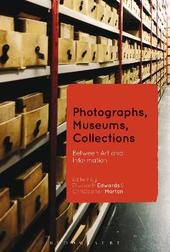
|
Photographs, Museums, Collections: Between Art and Information
Hardback
Main Details
| Title |
Photographs, Museums, Collections: Between Art and Information
|
| Authors and Contributors |
Edited by Professor Elizabeth Edwards
|
|
Edited by Christopher Morton
|
| Physical Properties |
| Format:Hardback | | Pages:256 | | Dimensions(mm): Height 234,Width 156 |
|
| Category/Genre | Photography and photographs |
|---|
| ISBN/Barcode |
9781472524928
|
| Classifications | Dewey:779.075 |
|---|
| Audience | | Professional & Vocational | |
|---|
| Illustrations |
20 colour and 52 bw illus
|
|
Publishing Details |
| Publisher |
Bloomsbury Publishing PLC
|
| Imprint |
Bloomsbury Academic
|
| Publication Date |
19 May 2015 |
| Publication Country |
United Kingdom
|
Description
The status of photographs in the history of museum collections is a complex one. From its very beginnings the double capacity of photography - as a tool for making a visual record on the one hand and an aesthetic form in its own right on the other - has created tensions about its place in the hierarchy of museum objects. While major collections of 'art' photography have grown in status and visibility, photographs not designated 'art' are often invisible in museums. Yet almost every museum has photographs as part of its ecosystem, gathered as information, corroboration or documentation, shaping the understanding of other classes of objects, and many of these collections remain uncatalogued and their significance unrecognised. This volume presents a series of case studies on the historical collecting and usage of photographs in museums. Using critically informed empirical investigation, it explores substantive and historiographical questions such as what is the historical patterning in the way photographs have been produced, collected and retained by museums? How do categories of the aesthetic and evidential shape the history of collecting photographs? What has been the work of photographs in museums? What does an understanding of photograph collections add to our understanding of collections history more broadly? What are the methodological demands of research on photograph collections? The case studies cover a wide range of museums and collection types, from art galleries to maritime museums, national collections to local history museums, and international perspectives including Cuba, France, Germany, New Zealand, South Africa and the UK. Together they offer a fascinating insight into both the history of collections and collecting, and into the practices and poetics of archives across a range of disciplines, including the history of science, museum studies, archaeology and anthropology.
Author Biography
Elizabeth Edwards is Research Professor of Photographic History and Director of the Photographic History Research Centre, De Montfort University, Leicester, UK. Christopher Morton is Curator of Photograph and Manuscript Collections at the Pitt Rivers Museum, Oxford, UK and Lecturer in Visual and Material Anthropology at the Institute of Social and Cultural Anthropology, University of Oxford, UK.
ReviewsWhoever suspected that museums' photography collections could be digitized and then discarded will change their mind after reading this groundbreaking book that brings together leading academics and curators. Anonymous and mostly uncatalogued photographs are restored with not only their biographies, but also a material future, as a key to a broader understanding of collecting history. * Dr Costanza Caraffa, Head of Photo Library, Kunsthistorisches Institut in Florenz, Max Planck Institute, Italy * With breadth of vision and depth of understanding, this editorial collaboration constitutes a critical addition to the self-reflexive literature on museum history and practice, at the same time enlarging the history of photography as a field of study and shifting it onto a robust institutional plane. * Joan M. Schwartz, Professor, History of Photography, Queen's University, Kingston, Canada * This book is a compilation of essays about collecting and curatorial practices unique to photographic collections. The editors argue that issues related to the technical, ephemeral, and serial qualities of photographs, along with the medium's relatively short history, have led to their marginalization within museums, yet these collections are 'increasingly being understood as knowledge-objects in their own right.' An introductory chapter provides a theoretical and historical overview of the place of photographic collections in the museum setting. Developed as part of an international conference held in Leicester, England, and organized into five topical sections, the essays explore several notable photographic collections, the information value of photographs, the history of collecting photographs, and curatorial practices for photograph collections. Essays detailing how portrait photography solidified Charles Darwin's professional network and aided his work on evolution, examining photographs documenting revolution in Cuba of the 1950s and 1960s, and creating images of the Maori people of New Zealand illustrate the breath of this volume. It will be of particular interest to students of photographic history and museum professionals. Summing Up: Recommended. Graduate, research, and professional collections. -- P. A. Mohr, independent scholar * CHOICE *
|